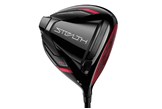Best TaylorMade Drivers 2024: head-to-head test
Published: Last updated:
What is the best TaylorMade driver for you in 2024? We reveal the ideal model for your golf game.
TaylorMade has been at the forefront of golf club innovation for more than 40 years and has produced some of the best golf drivers across that time.
TaylorMade’s first steel-headed driver – the Pittsburgh Persimmon that launched in 1979 – helped revolutionize the club-making industry and, more recently, the TaylorMade R7, the first movable weight driver, was another major innovation.
Today, TaylorMade make drivers that suit different types of golfer. Golfers battling a slice will benefit from the draw-biased Stealth 2 HD, high speed players will love the low-spin Stealth 2 Plus, while the standard Stealth 2 offers a brilliant combination of distance and forgiveness.
Best TaylorMade Drivers: at a glance
Best draw-biased TaylorMade driver: TaylorMade Stealth 2 HD | VIEW UK OFFER | VIEW US OFFER
Best low-spin TaylorMade driver: TaylorMade Stealth 2 Plus | VIEW UK OFFER | VIEW US OFFER
Most forgiving TaylorMade driver: TaylorMade Stealth 2 | VIEW UK OFFER | VIEW US OFFER
Some of the best players in the world use TaylorMade drivers, including Rory McIlroy, Tommy Fleetwood, and Collin Morikawa, but which model should you use? Let’s take a deeper look…

TaylorMade Stealth 2 Plus Driver
RRP: £529 | VIEW UK OFFER | VIEW US OFFER
Lofts: 8° / 9° / 10.5° | Stock shaft: Mitsubishi Kail’li Red, Project X HZRDUS Black
If there was a recurring criticism of the original Stealth Plus, whose carbon fiber face delivers greater ball speed through improving energy transfer, it was that the model wasn’t the most forgiving. A new carbon fiber sole and back ring address the issue with this new model. With an MOI that’s 10% higher (7,400g cm2) than its predecessor, the new Stealth 2 Plus brilliantly addresses that.
If it’s the ball speed you’re after, you’ll be pleased to hear the Stealth 2 family produced the fastest average ball speeds within our entire test. At our 10.5° test loft, the data has the Stealth 2 Plus five yards back from the Ping G430 LST. In this set-up, the model gave our pro his smallest carry distance drop-off (nine yards), the least amount of left-to-right dispersion (18.2 yards), and it hit shots into the tightest shot area (163.8 yds2) within the low-spin category. So Stealth 2 will be very playable on the course.
Stepping the loft down to 9°, which TaylorMade like fitting our Test Pro into as less loft means more ball speed, he rinsed out another four yards of carry, making the Stealth 2 Plus our longest 2023 driver for total distance (307 yards). Interpreting stats is only opinion, but however you look at it, Stealth 2 Plus is fast, long, and forgiving for a low-spin driver. It’s a brilliant choice for golfers who don’t spray shots across the driver face and those who need the 15g sliding sole weight to dial in a specific shot shape.
Read our full TaylorMade Stealth 2 Plus driver review.


TaylorMade Stealth 2 Driver
RRP: £499 | VIEW UK OFFER | VIEW US OFFER
Lofts: 9° / 10.5° / 12° | Stock shaft: Fujikura Ventus Red TR
The Stealth 2 family are TaylorMade’s first drivers to be constructed from a higher percentage of carbon fiber than titanium. In a very un-TaylorMade way, the company have used the weight-saving advancements to boost forgiveness over more speed and distance claims, which should be music to the ears of golfers who felt the first-generation Stealth drivers weren’t quite as forgiving as the competition.
At our 10.5° test loft, the cracking-looking Stealth 2 was our joint longest forgiving driver of 2023 (with the Mizuno ST-X 230 and Yonex Ezone GS i-Tech) at 276 yards, making the model a worthy recipient of TG’s ‘Best of 2023’ award.
Throw in a third-best left-to-right dispersion (33.8 yards), plus a slightly skewed heel sweet spot, and a picture emerges of this being a better performing driver for club golfers than its predecessor, which our data highlighted as a little timid compared to its more powerful Plus sibling.
Dialing the loft down to 9°, which is where TaylorMade fitted our tester for loft (even though he never uses a 9° driver on the course), upped ball speed by 1.1mph and added an additional seven yards of carry.
All in all, this complex driver construction stacks up in terms of look, sound, and feel. And because the data spells out excellent distance and forgiveness performance, it warrants a place on your shortlist.
Read our full TaylorMade Stealth 2 driver review.


TaylorMade Stealth 2 HD Driver
RRP: £499 | VIEW UK OFFER | VIEW US OFFER
Lofts: 9° / 10.5° / 12° | Stock shaft: Fujikura Speeder NX RedTaylorMade Stealth 2 HD Driver Deals
Perfect for golfers seeking draw bias and distance.
Many golfers think draw drivers are the most forgiving models in any brand’s line-up. Yet in reality, moving weight forward and into the heel to get a draw-enhancing weight bias often lowers MOI and forgiveness.
We applaud, then, how TaylorMade’s Stealth 2 HD driver is, for the first time, both the brand’s most forgiving and most draw-biased set-up. We also love the attention to detail in upping the lie angle to encourage a right-to-left ball flight (for right-handers) and shortening shaft length by a quarter of an inch, which breeds confidence and encourages hitting center face more often.
As with our low-spin and forgiving driver samples, TaylorMade cheekily sent 9° test heads rather than our specified 10.5°s. To ensure fairness as much as possible, we dialed the loft up to 9.75°. In 2022 the original Stealth HD was spot on data-wise, this year’s results were similarly impressive. By a whisker, it was again our longest draw driver, but it also produced our third-smallest left-to-right dispersion, which wasn’t the case in 2022.
All in all, Stealth 2 HD is hugely impressive, a driver tailored to slicers and those needing forgiveness more than ever before. Drivers don’t come any better looking, and with a full-on carbon fiber body, we really are struggling to see where future improvements might come from.
For 2023, Nelly Korda has signed a multi-year deal with TaylorMade to play a full bag of their equipment, after testing a range of all the new TaylorMade gear she decided to game the Stealth 2 HD driver. Korda’s consistent delivery and desired draw shot shape made the Stealth 2 HD driver a perfect pair as she noted liking the look and feel of the draw bias head.
Read our full TaylorMade Stealth 2 HD driver review.


TaylorMade Stealth driver
RRP £469 | VIEW UK OFFER | VIEW US OFFER
Lofts 9º / 10.5º / 12º | Stock shaft Fujikura Ventus Red 5
Stealth has a 60-layer carbon-fiber face to remove inefficient mass from the front of the driver. TaylorMade say it gives better energy transfer at impact and additional ball speed and is the choice of four-time Major winner Rory McIlroy
The Stealth also has an MOI 15% higher than the Stealth Plus, meaning you can expect 200-300rpm more backspin (so the Stealth is a mid to low-spin driver) than the Plus, along with a mid-high launch and ball flight.
The best golf equipment brands make three or more different drivers for a very good reason. One model of any driver family will suit a particular golfer better than the rest, and because one stands out, the others (when hit by the same golfer) can on the surface at least appear less attractive. This is exactly the case with the Stealth in our test pro’s hands.
Because the Stealth Plus suited him so well, the standard Stealth looks like an inferior choice. But be under no illusion, for the majority of club golfers that won’t be the case. The standard Stealth will offer a better combination of ball speed and backspin which will optimize carry distance, and thanks to the extra 15% MOI it will be more forgiving and easy to live with on the golf course.
For the standard Stealth’s extra forgiveness, our test pro gave up 1.8mph of ball speed (versus Stealth Plus, but back-weighted forgiving drivers never generate the fastest ball speeds) and 14 yards of carry, yet it still produced the fourth fastest ball speed in this category.

By including the Stealth amongst our five best forgiving drivers of 2022 we’re saying we love and can see the benefit in the better energy transfer concept of a carbon fiber face, but we’re not saying everyone needs to go buy one. But if you’re considering buying a new driver this year, the Stealth drivers have to be on your shortlist.
Read our full TaylorMade Stealth driver review.


TaylorMade Stealth Plus driver
RRP £499 | VIEW UK OFFER | VIEW US OFFER
Lofts 8° / 9° / 10.5° | Stock shafts Project X Hzrdus, Smoke Red RDX 60 (mid-flight), Mitsubishi Kai’li White 60 (low flight)
The Stealth Plus+ has a 60-layer carbon fiber face, which removes inefficient mass from the driver face to improve energy transfer at impact, so golfers get extra ball speed.
A 10g sliding sole weight helps dial in shot shape or improve ball speed (when positioned behind a golfer’s typical impact location).
TaylorMade say this model will be most at home in the hands of golfers who want to chase distance through lowering spin, as well as players who like more workable drivers and those who have a particular shot shape preference. It is the driver used by 2011 Open champion Collin Morikawa.
Never, in 15 years of testing, have we seen a driver outperform its peers by 12 yards of carry. Usually, once our pro’s data has been averaged, there’s rarely more than a handful of yards covering off-the-top models. And a performance difference that small can easily be caveated with “data can be reversed or slightly different on another day’s testing”. But double-digit carry distance gains are utterly unheard of, until this year.
We’ll admit to being pretty shocked by Stealth Plus putting in such a strong performance. We’d tested the model before (in creating our YouTube video) when it outperformed Callaway and Ping models, with tidy but not ground-breaking ball speed and carry distance gains (2.8mph of ball speed and four yards of carry distance gain over the longest). But those numbers were blitzed in our 2022 driver test.
The difference in part at least can be explained in switching Neil Wain out of a recommended shaft (that to him felt like hard work) and into the stock (low flight) Mitsubishi Kai’Li… and are we glad we did.
To put Stealth’s performance into context, the model produced a ball speed of 1.1mph faster than any low-spin driver we hit. By 12 yards, it was the longest driver within the category (it was also our longest overall driver by three yards).
The Plus was flat-out No.1 at protecting ball speed loss on off-center hits and second-best at minimizing carry distance drop-offs (only beaten by PXG’s 0811 Gen4 X by two yards). In anybody’s book that’s an outstanding across-the-board performance.
After what we’ve seen, we’re comfortable naming the Stealth Plus as our best low-spin driver of 2022, an award we’ve never bestowed upon a single model (whether low-spin, forgiving or draw-biased) before. We’re certainly not saying everyone will see a gain of 12 yards. What we are saying is that if you’re looking at buying a new low-spin driver in 2022, hit the Stealth.

To put some context around our test pro’s performance, Neil has never played a TaylorMade driver before. He’s now very excited about getting the Stealth Plus out onto the golf course, particularly because he loves the crisp sound just as much as any performance gain. In the past, he has shied away from super low-spin drivers, because their forward CG is less forgiving.
But we feel Stealth Plus isn’t the very lowest spinning driver out there, hence why it suits Neil so well. So a switch to this lower spinning model (even though it might not be the lowest spinning driver available) will give an immediate gain in ball speed.
Thanks to slightly less spin there will be a decent distance gain. But as it’s not super low-spin, chances are he will also hit the fairway more often than not, and that’s just the sort of equation lots of decent golfers could replicate for themselves by switching to Stealth Plus this year.
Read our full TaylorMade Stealth Plus driver review.


TaylorMade Stealth HD driver
RRP £469 | VIEW UK OFFER | VIEW US OFFER
Lofts 9° / 10.5° / 12° | Stock shaft Fujikura Air Speeder 45
HD stands for High Draw, which means the model is specifically tailored to eliminate the distance-zapping slice spin that afflicts tons of club golfer drives.
TaylorMade say some draw drivers have weight lumped in the heel, which inadvertently lowers MOI forgiveness (as the CG is closer to the face), a trap the Stealth HD doesn’t fall into.
Our test results show Stealth’s carbon fiber face doesn’t just improve energy transfer at higher swing speeds. There’s additional ball speed performance to be had here for more moderate-speed players, too. And that’s really exciting.
Compared to this year’s other draw drivers, the Stealth HD was Equipment Ed Simon Daddow’s fastest in terms of ball speed. It was also his longest-carrying driver over the Cobra King LTDx Max.
But what’s more impressive is how those numbers compare against his current driver (the Ping G400 SFT). Thanks to testing both we can see there’s a 1.6mph ball speed gain to be had by switching to Stealth HD, and thanks to the difference in spin, that could add up to a 21-yard carry distance gain, which of course is hugely significant.
Read our full TaylorMade Stealth HD driver review.


TaylorMade SIM2 driver
RRP £329 | VIEW UK OFFER | VIEW US OFFER
Lofts: 8°, 9°, 10.5° | Stock shaft options: Mitsubishi Tensei AV Raw 60, Project X HZRDUS Smoke RDX 70
TaylorMade can lay claim to creating the whole high launch/low spin movement as their SLDR in 2013 was the first to pitch the concept to golfers.
A 12% larger face than the original SIM puts a bigger area of the face at the maximum CT limit in SIM2.
The new carbon sole and aluminum back ring add up to a 5% gain in MOI over the previous model, too. Expect 200-300 less spin than the TaylorMade SIM2 Max.
Aluminium is a material that hasn’t been mentioned in driver design for decades, but incorporating it and a new carbon-fiber sole to nudge up forgiveness by 5% is a serious dedication to the cause of improving forgiveness.
The TaylorMade SIM2 (like its predecessor) is not just a great-looking driver; arguably it’s the most alluring driver story of the year.
By doing away with a weight track, not a single gram is wasted, so performance is utterly tailored to the target golfer.
The TaylorMade SIM2 was one of the best drivers of 2021, no doubt. Our data has it creating 1.4% less carry (275 yards) than our very longest, but that’s a minuscule difference.
A carry drop-off of less than 7% between good strikes and bad pushes SIM2 inside our top 10 drivers for forgiveness, which is a great result for a model that will find its way into many Tour bags.
Read our full TaylorMade SIM2 driver review.


TaylorMade SIM2 Max
RRP £399 | VIEW UK OFFER | VIEW US OFFER
Lofts: 9°, 10.5°, 12° | Adjustable?: Yes (+/- 2º) | Stock shaft: Fujikura Ventus Blue 50 or Mitsubishi Kuro Kage Silver 60
Just like an F1 team reconstructs their car every year to eke out every bit of performance, TaylorMade broke down the SIM2 to optimize driver construction in a new way.
The SIM2 family chased extra forgiveness by combining an aluminum back ring with a carbon-fiber sole and crown plus a sizeable 24g inertia increasing back weight.
SIM2 Max had a 5% larger face (which inspires confidence and means a bigger area can be at maximum flexibility) and 3% more MOI forgiveness than the previous SIM driver.
Most golfers never get to see what’s inside their driver, but our pro was blown away when he saw a demo breakaway SIM2 Max head; calling the internal engineering “absolutely incredible”.
The new aluminum back ring is beautifully CNC milled and thanks to TaylorMade’s construction method, not a single gram is positioned inefficiently. It’s a level of detail that just wasn’t possible a few years ago, and one you don’t get with every brand.
What does it mean in raw data terms? The TaylorMade SIM2 Max was a couple of yards behind the Callaway Epic Max (our longest forgiving driver) on carry distance. It was in front of Titleist, Ping, and Cobra, all of which are stellar competitors.
Read our full TaylorMade SIM2 Max driver review.


TaylorMade SIM2 MAX-D driver
RRP £399 | VIEW UK OFFER | VIEW US OFFER
Lofts: 9°, 10.5°, 12° | Adjustable?: Yes (+/- 2º) | Stock shaft: Fujikura AirSpeeder 45
Thanks to the new carbon fiber, and aluminum construction, along with 22g of back weight, TaylorMade reckon the Max D has 15% more MOI than the original, which means it is still one of the highest MOI draw drivers on the market.
A new AirSpeeder 45 shaft is light and will suit typical mid-slow-speed golfers who buy off the rack, while other shafts can be combined with this head for stronger players.
We’ve been big fans of TaylorMade’s D drivers ever since the first M2 D-Type back in 2017.
We love how the engineers have come up with some clever paintwork to beautifully disguise how the face sits a little closed at address.
It means the TaylorMade SIM2 MAX-D is a serious proposition for any slicer (with a proper shaft fitting), not just slower-speed players who struggle with a slice.
If you’re looking for a draw-biased driver, the TaylorMade SIM2 MAX-D must be on your shortlist.
Read our full TaylorMade SIM2 Max D driver review.

BEST TAYLORMADE GOLF DRIVERS – LADIES

TaylorMade Kalea Premier driver
RRP: £379 | VIEW UK OFFER | VIEW US OFFER
Loft: 12.5° | Stock shaft: Kalea Premier 40 Stock grip: Lamkin Sonar 38g
Lightweight speed, easy launch and maximum forgiveness pretty much sums up the story behind most women’s clubs. But a huge benefit of the Kalea Premier is the ability to custom fit them, which has not often been an option for women golfers.
Much like the TaylorMade SIM2 Max driver, the Kalea Premier boasts tour-proven tech (carbon crown and sole with aluminum back ring and an Inertia Generator at the back of the sole) which have all been tuned to offer slower swing speeds and higher launch with additional MOI forgiveness.

Golfers also get the brands Twist Face tech which promotes increased consistency on common mishits from the low-heel and high-toe areas of the face. A flexible Thru-Slot Speed Pocket in the sole also helps retain ball speed for shots impacting low on the face.
Read our full TaylorMade Kalea Premier driver review.

How we tested the drivers
The leading brands sent us their 2023 drivers in our Test Pro Neil Wain’s specs; draw models and those aimed at more moderate speeds were sent in Equipment Editor Simon Daddow’s specs.
We created an indoor test lab at Keele Golf Centre to ensure a controlled environment, which meant we could use premium Srixon Z-Star golf balls and a Foresight GC Quad launch monitor to create the most reliable data possible.
Major misses were rejected, but we recorded how shots launched, span, peaked out, and how far they flew in which direction.
See more about how TG tests golf clubs and other equipment.
Best TaylorMade drivers: buying advice & FAQs
What does “SIM” stand for in a TaylorMade driver?
SIM stands for ‘Shape In Motion’, a concept which improves aerodynamics at the point in the swing where drivers experience most drag – from nine o’clock to six o’clock in the downswing – or just before impact, where you need speed to peak.
According to TaylorMade, typical drivers aren’t optimized for this critical point in the swing – most focus on speed in a straight line, not a swing arc.
Which is the best TaylorMade driver?
Whilst the improvements year-on-year are small, if you’re looking for the absolute best TaylorMade driver, the latest models will offer maximum performance, which means the TaylorMade Stealth 2.
Which TaylorMade Stealth 2 driver is best for you depends on whether you want low spin (Stealth 2 Plus), draw bias (Stealth 2 HD), or a blend of distance and forgiveness (standard Stealth 2).
Which TaylorMade driver is best for beginners?
Many beginner golfers struggle with a slice off the tee, which means the draw-biased TaylorMade Stealth 2 HD will be the best driver for them. A beginner who doesn’t have a slice will likely be best with the standard TaylorMade Stealth 2 driver.
BECOME A TODAY’S GOLFER MEMBER: Unlimited access to premium content and exclusive rewards

Simon Daddow
Today’s Golfer Equipment Editor
Simon Daddow is the Equipment Editor for Today’s Golfer. Having tested and played more than 10,000 clubs in his life, what he doesn’t know about golf clubs isn’t worth knowing.
He’s a specialist in all things metal having spent a large part of his career as a golf club maker and product development manager, and has worked in the golf industry for more than 30 years. Starting out as trainee professional at Downes Crediton GC where he learned the art of golf club making, he went onto work for Clubhaus Plc and Tony Charles Ltd as a golf club maker, and running Product Development at Benross Golf.
Simon also spent time working as a Sales Executive in Harrods’ golf department, even helping supply Sir Nick Faldo with personalized shirts in a last-minute emergency ahead of a flight to a tournament.
He joined EMAP Active (now Bauer Media) as Equipment Editor in 2006 and has worked for both Today’s Golfer and Golf World. Working alongside our test pro Neil Wain, Simon has made todays-golfer.com the most reliable source for golf club testing.
Despite his youthful looks, Simon has played golf for more than 40 years and plays to a handicap of 10. A lack of club speed means he’s short off the tee, but very handy from 125 yards and in.
He enjoys excellent relationships with the biggest names in the golf equipment industry, including PXG boss Bob Parsons and TaylorMade’s Tomo Bystedt and Adrian Rietveld.
Away from the course, Simon is a season-ticket holder at Peterborough United Football Club, attending games with his young son. He’s also a keen cyclist and enjoys working (and relaxing) at his allotment.
His favorite ever piece of golf equipment is the Callaway Warbird fairway wood and he considers the biggest technological advancement in the game to have been titanium driver heads.
Simon’s job means he plays regularly around the world, and rates Kingsbarns as his favorite course. He uses a PXG 0311 GEN6 XF driver, TaylorMade Stealth 2 HL (15º), Ping G400 (20.5º), PXG 0317 X Gen2 hybrid, PXG 0311 GEN6 P irons (6–PW), Cleveland CBX2 wedges (52°, 58°), Ping 21 Fetch putter and a TaylorMade Tour Response golf ball.
You can contact Simon via email and follow him on Twitter for loads more golf equipment insight.
-
 Best TaylorMade drivers in 2023.
Best TaylorMade drivers in 2023.
-
 Collin Morikawa uses the TaylorMade Stealth Plus driver
Collin Morikawa uses the TaylorMade Stealth Plus driver
-
 Dustin Johnson uses the TaylorMade Stealth driver at the open LIV event
Dustin Johnson uses the TaylorMade Stealth driver at the open LIV event
-
 Rory McIlroy uses the TaylorMade Stealth driver
Rory McIlroy uses the TaylorMade Stealth driver
-
 The Sim2 is one of the best TaylorMade drivers
The Sim2 is one of the best TaylorMade drivers
-
 The Kalea is one of the best TaylorMade drivers
The Kalea is one of the best TaylorMade drivers
-
 The Ladies Stealth HD is one of the best TaylorMade drivers
The Ladies Stealth HD is one of the best TaylorMade drivers
-
 The M4 is one of the best TaylorMade drivers
The M4 is one of the best TaylorMade drivers
-
 The M4 is one of the best TaylorMade drivers
The M4 is one of the best TaylorMade drivers
-
 The M4 is one of the best TaylorMade drivers
The M4 is one of the best TaylorMade drivers
-
 The Sim2 Max D is one of the best TaylorMade drivers
The Sim2 Max D is one of the best TaylorMade drivers
-
 The Sim2 Max is one of the best TaylorMade drivers
The Sim2 Max is one of the best TaylorMade drivers
-
 The Sim2 is one of the best TaylorMade drivers
The Sim2 is one of the best TaylorMade drivers
-
 The Stealth is one of the best TaylorMade drivers
The Stealth is one of the best TaylorMade drivers
-
 The Stealth is one of the best TaylorMade drivers
The Stealth is one of the best TaylorMade drivers
-
 The Stealth is one of the best TaylorMade drivers
The Stealth is one of the best TaylorMade drivers
-
 The Stealth Plus is one of the best TaylorMade drivers
The Stealth Plus is one of the best TaylorMade drivers
-
 The Stealth is one of the best TaylorMade drivers
The Stealth is one of the best TaylorMade drivers
-
 The Sim2 is one of the best TaylorMade drivers
The Sim2 is one of the best TaylorMade drivers
-
 Colin Morikawa hitting the TaylorMade Stealth 2 Plus Driver.
Colin Morikawa hitting the TaylorMade Stealth 2 Plus Driver.
-
 TaylorMade Stealth HD Driver.
TaylorMade Stealth HD Driver.
-
 TaylorMade Stealth Plus+ Driver.
TaylorMade Stealth Plus+ Driver.
-
 Tommy Fleetwood hitting the TaylorMade Stealth 2 Plus Driver.
Tommy Fleetwood hitting the TaylorMade Stealth 2 Plus Driver.
